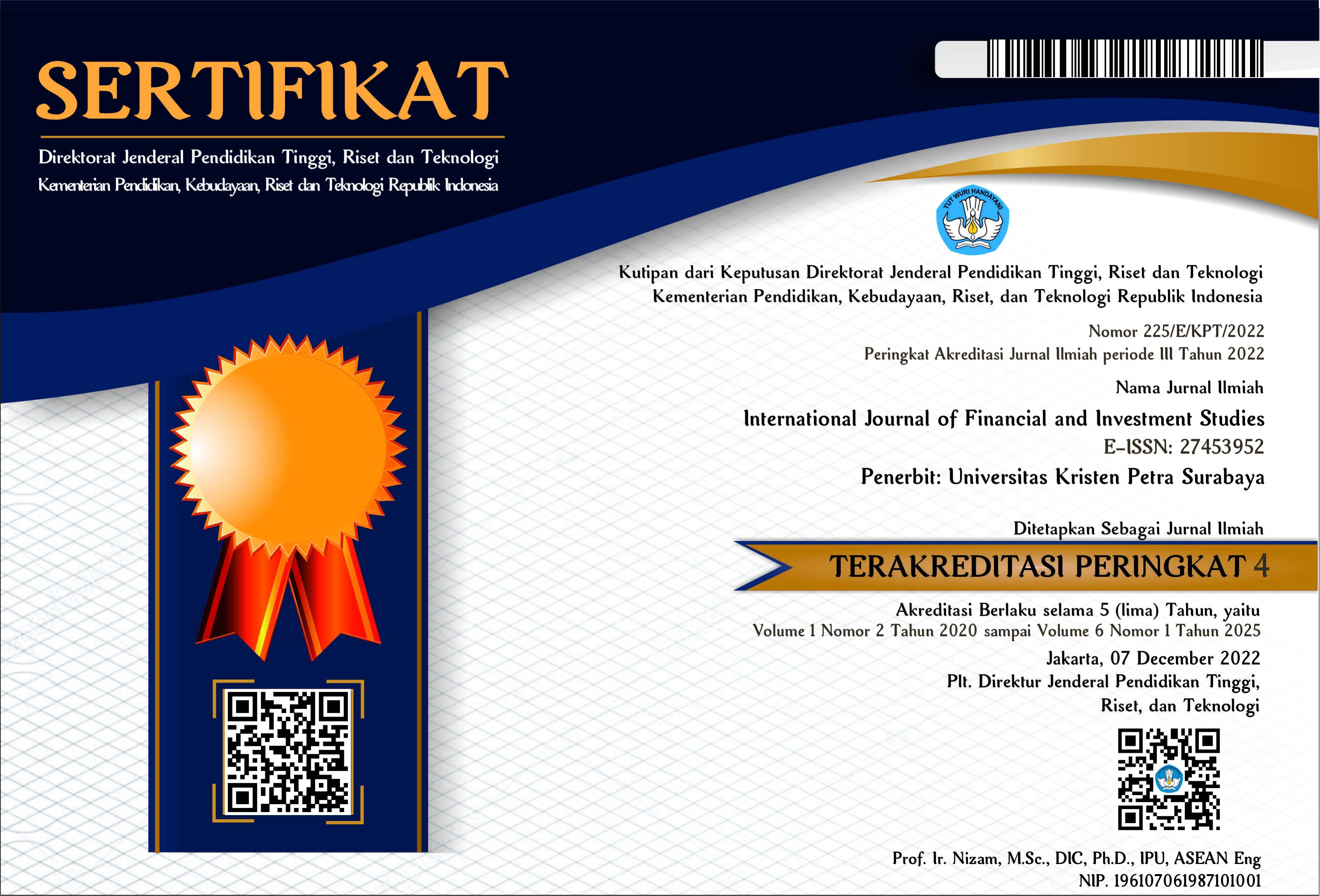COMPARISON OF INVESTMENT STRATEGIES IN INNOVATION AND NON-INNOVATION PORTFOLIOS WITH PORTFOLIO OPTIMIZATION
Abstract
This study aims to examine whether asset allocation strategies to the innovation sector can provide superior portfolio performance to investors. This type of research is comparative research using secondary data sources. The sample used is ETFs (Exchange Traded Funds) from investment companies namely BlackRock and Ark Invest since 2015. The focus of this study is to compare the performance of portfolios without an allocation to innovation assets and portfolios with allocations to innovation assets. This study analyzes the difference in performance between the two portfolios for various weightings and several portfolio optimization approaches, such as 'equal weighting' (1/N), optimality Lagrange, minimum-variance (MinVar), mean-variance (MV), and market-value weighted strategy.
Downloads
References
Abidin, S. Z., & Haron, R. (2006). Correlation and Benefits of Portfolio Diversification among Equity Markets of Developed Countries and Emerging Countries in South East Asia Region. International Journal of Economics and Management, 1(1). 43-66.
Ardia, D., Boudt, K., & Nguyen, G. (2018). Beyond Risk-Based Portfolios: Balancing Performance and Risk Contributions in Asset Allocation. Quantitative Finance. 18(8). 1249-1259. 10.1080/14697688.2018.1424349
Bessler, W., Taushanov, G., & Wolff, D. (2021). Factor Investing snd Asset Allocation Strategies: A Comparison of Factors Versus Sector Optimization. Journal of Asset Management. 22. 10.1057/s41260-021-00225-1.
Biktimirov, E., & Barnes, T. (2003). Definitions of return. Journal of Accounting and Finance Research. 11. 24-37.
Bruce, D. (2007, December 13). Chairman Frustrated by 'Nonsense'. Otago Daily Times. Retrieved from http://www.odt.co.nz.
Chavez, R., & Fine, A. (2018, August 20). Framing Disruption Risk. Retrieved from Oliver Wyman: https://www.oliverwyman.com/our-expertise/insights/2018/aug/framing-disruption-risk.html.
Jayeola, D., Ismail, J., Sufahani, S. F. (2017). Effects of Diversification of Assets in Optimizing Risk of Portfolio. Malaysian Journal of Fundamental and Applied Science, 13(4), 584-587.
Grubel, H. (1968). Internationally Diversified Portfolios. American Economic Review, 58(1968), 1299-1314.
Hartono, J. (2010). Portfolio Theory and Investment Analysis. Yogyakarta: BPFEUGM.
Leggi, R. (2020, May 27). Rethinking Asset Allocation. New York: ARK Invest Management LLC.
Lev, B., & Sougiannis, T. (1999). Penetrating the book9to9market Black Box: The R&D Effect. Journal of Business Finance and Accounting, 26(3–4): 419–49.
Markowitz, H. (1952). Portfolio Selection. The Journal of Finance, 7(1), 77–91. https://doi.org/10.2307/2975974.
Tandelilin, E. (2010). Portfolios and Investments: Theory and Applications. 1st edition. Kanisius. Yogyakarta.
Von Neumann, J., & Morgenstern, O. (1944) Theory of Games and Economic Behavior. Princeton: Princeton University Press.
Wieland, I., Levente, K., & Savchenko, T. (2020). Conceptual Study of the Difference between the Money Market and the Capital Market. Financial Markets, Institutions and Risks. 4(1), 51-59. 10.21272/fmir.4(1). 51-59.2020.
Yu, P., Lee, J. S., Kulyatin, I., Shi, Z., & Dasgupta, S. (2019). Model-based Deep Reinforcement Learning for Financial Portfolio Optimization
Authors who publish in this journal agree to the following terms:
- Authors retain unrestricted copyright and full publishing rights. The authors grant the Publisher the right of first publication, with the work simultaneously licensed under the terms and conditions of the Creative Commons Attribution 4.0 International License.
- Authors can enter into separate, additional contractual arrangements for the non-exclusive distribution of the journal's published version of the work (e.g., post it to an institutional repository or publish it in a book), with an acknowledgment of its initial publication in this journal.
- Authors are permitted and encouraged to post their work online (e.g., in institutional repositories or on their website) before and during the submission process, as it can lead to productive exchanges and earlier and more extraordinary citations of published work.















